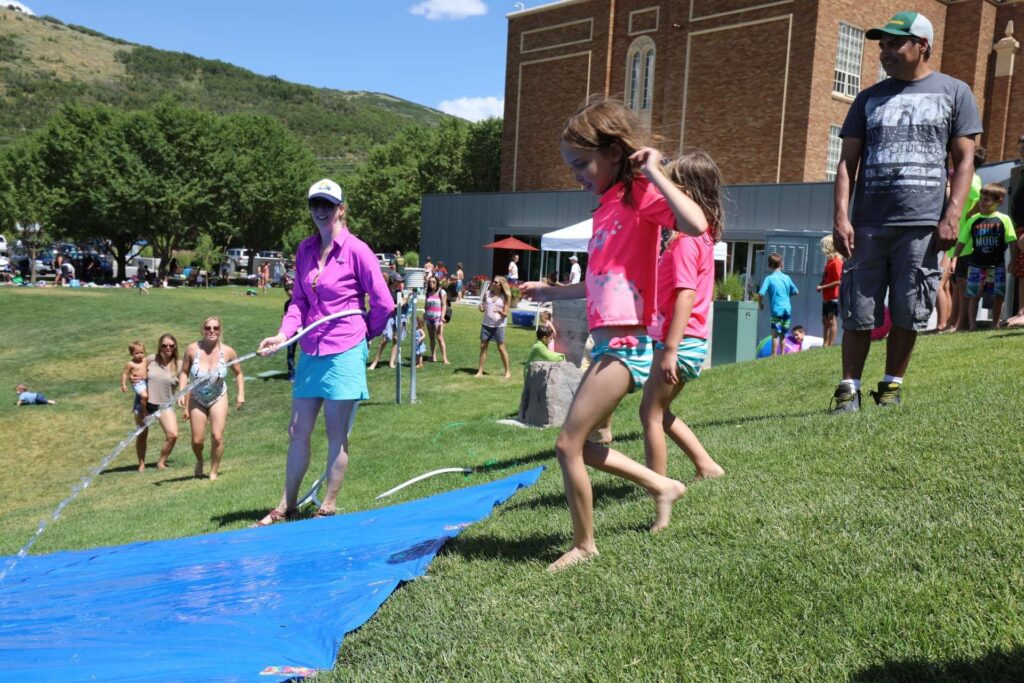
Every summer, we host fun “Summer Slide” parties for kids. They get to slip and slide, make huge bubbles, enjoy a big water balloon fight, and do crafts. Parents, we offer this time for you to learn about “summer slide” in regards to children’s education.
Top 10 Things To Do To Prevent “Summer Slide”
“Summer slide” happens when young minds sit idle for three months. According to a report from the National Summer Learning Association, “a conservative estimate of lost instructional time is approximately two months or roughly 22 percent of the school year.” This means that when children go back to school in the fall, teachers have to spend at least a month re-teaching fundamental skills learned the year before. For example, it’s forgetting to capitalize proper nouns but not common nouns, the difference between they’re, there, and their, the difference between a “b” and a “d,” or not reading as fluently as a few months prior. Here are Park City Library’s favorite ways to prevent “summer slide.”
#1: Introduce something new, in hopes that it turns into a passion
Going to the zoo? Try to instill an interest in lions. Going on vacation? Have your child learn about the new city. Going camping? Check out the library’s telescope and see if they are interested in constellations or planets.
#2: Connect math to everyday tasks
Make math daily and joyful. Sort laundry into shapes. Pay for a snack with exact change. Find out how many miles it takes to get to a friends house. How much sand does it take to make a sandcastle?
#3: Read aloud to your child
Reading aloud to your child starts when they are a baby and should go into middle school. This family bonding activity helps your child create an interest in reading, expand their attention span, and improves language retention and comprehension.
#4: Take every opportunity to read
Show your child that reading is everywhere. Read street signs, billboards, and backs of cereal boxes. Even try subtitles on the TV!
#5: Keep reading material around the house
Keep a wide variety of reading material at different locations in the house. Have books, magazines, newspapers, and comics at your kitchen table, in your bathroom, in your living room, etc. If your child has easy access to reading materials, they’ll be more likely to pick something up themselves.
#6: All reading is good reading
As long as your child is reading something, this will prevent “summer slide.” Let them pick from popular novels, books about their interests, books they have read before, comics, audiobooks, and online articles. If your child reads what they enjoy, their reading skills improve and their confidence increases.
#7: Take your children to the library regularly
Libraries are a place to let your kids practice selecting books themselves. Make your library visit one where your child can pick out a books of their interest, play with technology, attend an event, and/or play in the Library Field. Children will often put more effort into trying out a book that they’ve selected on their own.
#8: Make goals for summer reading and learning
Setting goals is an important skill to learn at any age. Will your child be more willing to read for 20 minutes a day or a set number of books as a goal? If your child is a reluctant reader, aim at just six books; this is just enough to keep your child from regressing.
#9: Invest in the right kind of screen time, such as Kanopy
Balance, yet embrace video games and smart phones. Theses are used for entertainment, but are also tools your child needs. Shift your child’s screen time from playing, to learning, to doing. Will they be interested in coding or making up their own game? Have you tried Kanopy? It is free movie screaming with your library card. They feature books turned into short films. Kids love it – parents too!
#10: Prepare for the return
Build excitement about going back to school. What friends are they excited about seeing? What will they share about their summer vacation? What did they learn about last year that they hope to learn more about this year?